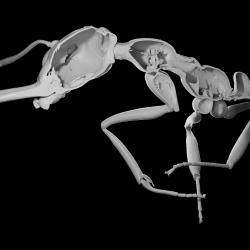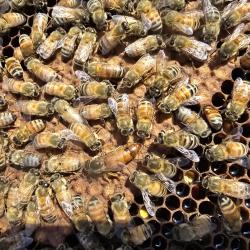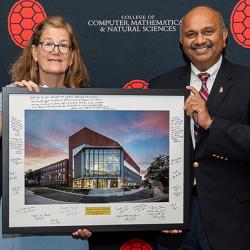Join Our College for Maryland Day on Saturday, April 29
The College of Computer, Mathematical, and Natural Sciences will host 39 events
Explore our world of innovation and learning on Maryland Day! Maryland Day is an opportunity for prospective students and community members to learn more about the University of Maryland – and find out how the College of Computer, Mathematical, and Natural Sciences is reimagining teaching and learning to prepare the next generation of scientific leaders for success.
Unlock a world of learning, discovery and exploration, with hundreds of family-friendly festivities including exhibits, workshops, hands-on demonstrations, performances, cross-campus tours, lectures, petting zoos and athletic events.
Maryland Day will be held on Saturday, April 29, 2023, from 10 a.m. to 4 p.m., rain or shine. Admission and parking are free – see this campus map. Join CMNS on Science & Tech Way for the 39 events listed below!
Brendan Iribe Center for Computer Science and Engineering
-
AI Feedback for Violin Instruction – Lobby, 10 a.m. to 4 p.m.
-
The Perception and Robotics Group is focused on bio-inspired research involving robotic systems, artificial intelligence (AI) and autonomous drones. See its latest project, an AI-driven teaching assistant for violin that offers feedback and instructional guidance to aspiring musicians. Researchers also showcase miniaturized drones designed to pollinate flowers.
-
-
Break Through Tech – Lobby, 10 a.m. to 4 p.m.
-
Meet members of a national program working at the intersection of academia and industry to propel women and underrepresented communities into technology. Learn more about how you can join this inclusive community as a student, mentor or industry partner.
-
-
CompSciConnect: Not Your Typical Summer Camp – 1st Floor, 10 a.m. to 1 p.m.
-
CompSciConnect is a three-year summer day camp based in the Iribe Initiative for Inclusion and Diversity in Computing for middle schoolers to explore fields of computer science. See projects by current participants in robotics, app development, Python art, dynamic web design and 3D game design.
-
-
Computer Science Advising – Lobby, 10 a.m. to 4 p.m.
-
UMD's computer science major ranks No. 8 among the country’s public undergraduate programs, according to U.S. News & World Report. Learn more about it from academic advisors and current students.
-
-
Immersive Media Design – Room 0110 and AVW Lab, 10 a.m. to 4 p.m.
-
The immersive media design major combines students' artistic talents with computer science. Stop by to view students' and faculty members' interactive projections and virtual reality and augmented reality-based projects.
-
-
Maryland Robotics Center – Lobby, 10 a.m. to 4 p.m.
-
The Maryland Robotics Center, an interdisciplinary research center housed in the Institute for Systems Research, offers demonstrations and posters of robotics research, as well as lab tours.
-
-
Technica Hacks – Iribe Center Patio, 10 a.m. to 4 p.m.
-
Technica is the world's largest hackathon for underrepresented genders, hosted annually by UMD students. Meet the "hacks" who promote the diversity of people in the tech industry as well as encourage underrepresented genders of all majors to pursue careers in technology.
-
-
The Mokhtarzada Hatchery – Lobby, 10 a.m. to 4 p.m.
-
Join student founders in the Mokhtarzada Hatchery, a place where startups are supported with seed funding, working space and mentoring. Watch demos and hear firsthand from students about how they are turning their startups into viable, sustainable ventures.
-
Chemistry Building
-
Alka-Seltzer Lava Lamps – Front lawn, 10 a.m. to 4 p.m.
-
Watch students' homemade mini lava lamps come to life after adding a tablet of Alka-Seltzer.
-
-
Dry Ice Bubbles – Front lawn, 10 a.m. to 4 p.m.
-
Catch a bubble with your own hands from bubbles made from dry ice.
-
-
Red Cabbage Juice Indicator – Front lawn, 10 a.m. to 4 p.m.
-
Conduct an experiment with red cabbage juice, a natural indicator, and use it to test the pH of different solutions.
-
-
Thermochromic Slime – Front lawn, 10 a.m. to 4 p.m.
-
Play with slime that changes color at different temperatures.
-
-
UV Color-Changing Bracelets – Front lawn, 10 a.m. to 4 p.m.
-
Come make a bracelet with beads that change color in the sun.
-
Geology Building
-
Earth's Fury: Understanding Earthquakes and Volcanoes – Front lawn, 10 a.m. to 4 p.m.
-
Dangerous volcanic eruptions occur after liquid rock and hot gases rise from great depths to Earth's surface. Earthquakes cause buildings to sink as wet soil liquefies, enveloping cars and skyscrapers. Watch demonstrations that help explain how these events continue to shape our earth.
-
-
Minerals and the Earth: The Stuff of Life – Room 2118, 10 a.m. to 4 p.m.
-
See and touch pieces of a planet's insides. These minerals, rocks and gems are the raw materials of life.
-
-
Moonquakes and Marsquakes – Front lawn, 10 a.m. to 4 p.m.
-
Create your own "moonquakes" and discover how NASA and UMD are helping to prepare astronauts to explore rocky worlds. Learn about the tools that Apollo astronauts used on the surface of the moon and those we may send with astronauts headed there in this decade.
-
-
Volcanoes! – Front lawn, 10 a.m. to 4 p.m.
-
Learn about the inner workings of volcanoes and the forces that lead to their eruptions. Do you have what it takes to be a volcanologist? Test your skills by learning to identify crystals in samples of pumice and ash from an explosive eruption of Cerro Machin in Colombia.
-
Glenn L. Martin Building
-
Ask an Astronomer – Front lawn, 10 a.m. to 4 p.m.
-
Faculty and students answer your perplexing astronomy-related questions.
-
-
Earth System Science and Climate Change – Front lawn, 10 a.m. to 4 p.m.
-
Explore our planet with scientists from the university, NASA and the National Oceanic and Atmospheric Administration. Enjoy educational and entertaining Earth science-themed activities: How much water can you squeeze from a cloud? How can virtual reality help us learn about lightning and flash-flood safety?
-
-
Fingerprinting the Universe – Front lawn, 10 a.m. to 4 p.m.
-
Each person has a unique fingerprint. So does each chemical element in our bodies and the universe itself, encoded in light. Learn how astronomers study the skies using different wavelengths of light and how they decode the light to unravel the mysteries of the universe.
-
-
Fun with Light! – Front lawn, 10 a.m. to 4 p.m.
-
Watch demonstrations of fundamental principles of light and fun optical effects using interactive experiments.
-
-
Looking Into the Cosmos – Front lawn, 10 a.m. to 4 p.m.
-
Join the AstroTerps, the Terrapin Astronomy Society, to explore the familiar and not-so-familiar sights of the universe. How many can you identify?
-
-
Maryland's Weather and Climate – Front lawn, 10 a.m. to 4 p.m.
-
Learn about Maryland's weather, how the materials we use to build cities make where we live hotter, and play with a tornado in a bottle.
-
-
Microbes & Computers... Oh My! – Front lawn, 10 a.m. to 4 p.m.
-
Stop by for several activities related to the human microbiome and computational analyses of microbiome data.
-
-
Our Neighbor, NASA Goddard – Front lawn, 10 a.m. to 4 p.m.
-
Around the corner and around the galaxy: NASA's Goddard Space Flight Center, five miles away in Greenbelt, builds spacecraft and instruments and invents technology to study the earth, the sun, the solar system and the universe. Discover how its mission affects you.
-
-
Paleoclimate CoLaboratory – Front lawn, 10 a.m. to 4 p.m.
-
Learn from scientists and students studying ancient climates how we put present-day climate change into a longer-term context. Can you find the lucky cats in the isotope lab?
-
-
Puzzles and Brain Teasers – Front lawn, 10 a.m. to 4 p.m.
-
Play with puzzles and other brain teasers brought to you by UMD's math wizards.
-
-
Solar Observing – Front lawn, 10 a.m. to 4 p.m.
-
Take a safe look at the big, bright, yellow (or red, depending on the filter) ball in our sky through telescopes with UMD Astronomy Observatory staff.
-
Hornbake Plaza
-
Maryland Wildlife Quest – 10 a.m. to 4 p.m.
-
Explore the wildlife of Maryland and contribute to a Chesapeake Bay and Appalachian Mountains mural.
-
-
Who’s That Scientist? – 10 a.m. to 4 p.m.
-
Play a game with UMD's chapter of the Society for Advancement of Chicanos/Hispanics and Native Americans in Science to learn about prominent Chicano/Hispanic and Native American scientists around the world and at UMD.
-
John S. Toll Physics Building
-
Liquid Nitrogen Ice Cream – Front lawn, 12:30 to 2 p.m.
-
Bet you haven't had ice cream like this! This homemade specialty tastes great and is safe for all ages. Try it, while supplies last.
-
-
Physics Demos Film Festival – Room 1410, 2 to 3 p.m.
-
Enjoy a selection of physics demonstration videos produced by faculty, staff and students.
-
-
Physics Is Phun – Front lawn, 10 a.m. to 4 p.m.
-
Students and faculty from the Department of Physics share fantastic demonstrations that explore and explain some of the amazing principles and concepts of the universe.
-
Physical Sciences Building
-
Can You Move Like a Cell? – Outside, 10 a.m. to 4 p.m.
-
Collective motion is important to cells of all types: Skin cells that move collectively are better at healing wounds, and immune cells that work together are better at detecting and eliminating infections. "Move like a cell" in games like follow the leader while a camera tracks you, or check out the new acoustic levitation demonstration.
-
-
Radar Velocity – Outside, 11 a.m. to 3 p.m.
-
Test your throwing ability at the Radar Velocity Detector Station.
-
-
Smoke Cannons – Outside, 10 a.m. to 4 p.m.
-
Two cannons make for amazing motion when rings collide.
-
-
Think Quantum: Magnetic Levitation – Outside, 10 a.m. to 4 p.m.
-
See levitating superconductors, cooled by liquid nitrogen and zoom along a magnetic track.
-
Physics Welding Shop
-
Vortex Makerspace – 11 a.m. to 2 p.m.
-
Find fun, hands-on activities at the Department of Physics' makerspace, which encourages learning, investigation and collaboration through practical projects in electronics, fabrication, coding and more.
-
Plant Sciences Building
-
Discover a Swamp – First Floor Hallway, 10 a.m. to 3 p.m.
-
Capture and observe the small aquatic creatures that are common in nearby wetlands. Learn about their behavior as they swim through the water and climb on plants.
-
-
Insect Petting Zoo – First Floor Hallway, 10 a.m. to 3 p.m.
-
Imagine tarantulas, exotic insects, scorpions, bees and millipedes longer than your hand for you to look at and touch – if you dare.
-







